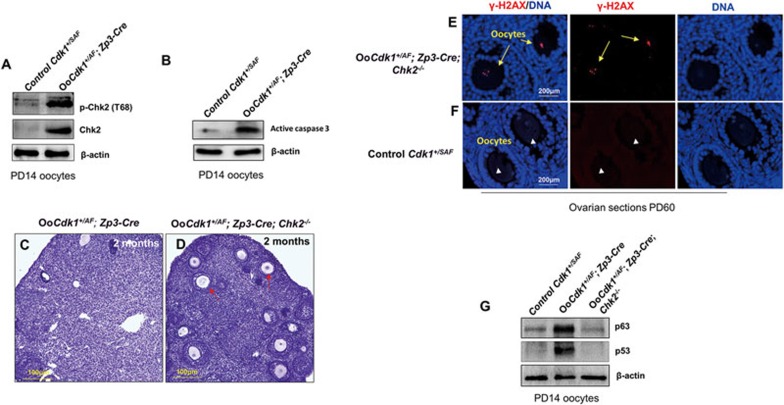Figure 5.
Cdk1AF triggers the Chk2-p63/p53 and cell death pathways in OoCdk1+/AF; Zp3-Cre oocytes. (A) Western blot for p-Chk2 (T68) and Chk2 in oocytes isolated from PD14 Cdk1+/SAF and OoCdk1+/AF; Zp3-Cre ovaries. (B) Western blot for active caspase 3 in oocytes isolated from PD14 Cdk1+/SAF and OoCdk1+/AF; Zp3-Cre ovaries. β-actin was used as the loading control. Lysate from 200 oocytes was loaded in each lane. The experiments were repeated more than three times each. (C, D) Hematoxylin-stained sections of mouse ovary at 2 month of age. Rescue of follicle depletion by the concomitant deletion of Chk2 in OoCdk1+/AF; Zp3-Cre ovaries. By 2 months of age, although healthy follicular structures and oocytes had mostly disappeared in mutant OoCdk1+/AF; Zp3-Cre ovaries (C), concomitant deletion of Chk2 largely prevented the death of follicles in double-mutant OoCdk1+/AF; Zp3-Cre ; Chk2−/− ovaries, and many surviving oocytes could be observed (D, arrows). The experiments were repeated more than three times each, and for each time and each age ovaries from one mouse of each genotype were used. (E) Surviving oocytes in PD60 double-mutant OoCdk1+/AF; Zp3-Cre ; Chk2−/− ovaries stained positive for γ-H2AX (arrows) indicating that DNA damage is still present. (F) Control Cdk1+/SAF ovaries with γ-H2AX-negative oocytes. The experiments were repeated more than three times, and representative images are shown. (G) Western blot for p63 and p53 levels in oocytes isolated from PD14 Cdk1+/SAF, OoCdk1+/AF; Zp3-Cre, and OoCdk1+/AF; Zp3-Cre ; Chk2−/− ovaries. β-actin was used as the loading control, and lysate from 200 oocytes was loaded in each lane. The experiments were repeated more than three times.

